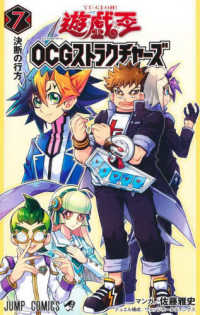- ホーム
- > 洋書
- > 英文書
- > Cinema / Film
Full Description
Video Game Design is a visual introduction to integrating core design essentials, such as critical analysis, mechanics and aesthetics, prototyping, level design, into game design.
Using a raft of examples from a diverse range of leading international creatives and award-winning studios, this is a must-have guide for budding game designers. Industry perspectives from game industry professionals provide fascinating insights into this creative field, and each chapter concludes with a workshop project to help you put what you've learnt into practice to plan and develop your own games.
With over 200 images from some of the best-selling, most creative games of the last 30 years, this is an essential introduction to industry practice, helping readers develop practical skills for video game creation. This book is for those seeking a career making video games as part of a studio, small team or as an independent creator. It will guide you from understanding how games engage, entertain and communicate with their audience and take you on a journey as a designer towards creating your own video game experiences.
Interviewees include:
James Portnow, CEO at Rainmaker Games
Brandon Sheffield, Gamasutra.com/Game Developer magazine
Steve Gaynor, co-founder The Fullbright Company (Gone Home)
Kate Craig, Environment Artist. The Fullbright Company (Gone Home)
Adam Saltsman, creator of Canabalt & Gravity Hook
Jake Elliott & Tamas Kemenczy, Cardboard Computer (Kentucky Route Zero)
Tyson Steele, User Interface Designer, Epic Games
Tom Francis, Game Designer, Gunpoint & Floating Point
Kareem Ettouney, Art Director, Media Molecule. Little Big Planet 1 & 2, Tearaway.
Kenneth Young, Head of Audio, Media Molecule
Rex Crowle, Creative Lead, Media Molecule
Contents
Chapter 1: Defining Games; What Do We Mean When We Say 'Game'?; Games Have Rules and Mechanics; Ludology; Games Have Always Been With Us; the Rhetorics of Play; Game Culture; Defining Culture; Beginning the Quest; Interview Adam Saltsman, Game Maker (Gravity Hook, Canabalt); Case Study: Cababalt
Chapter 2: World Building (Mechanics, Rules & Behaviors); When You Build a Game, You Construct a Universe; Games, Rules and Mechanics; The Building Blocks of Game Design ; The Field of Play; Game Mechanics, an Overview; Player Numbers as Mechanic; Rules of Play; Video Game Rule Taxonomy; Objects and Concepts; Restricting Actions; Circumstantial Effect; Outcomes of Play; Objectives of Play (Goals); Player Resources; Conflict (Resources); Case Study Kentucky Route Zero, Cardboard Computer
Chapter 3: Video game Analysis; Thinking Like a Game Designer; Understanding Bias; Recognising Bias; Starting the Analysis Process; Bias Informs the Mechanic (Cognitive Bias; Priming, Anchoring, Availability); First Order Optimal Strategies; Game Consistency; Becoming a Designer/Player; The Rollercoaster Experience; Interview James Portnow Ceo, Rainmaker Games/Director, Games for Good
Chapter 4: Understanding the Motivations for Play; Bartle's Taxonomy of Play; The Big Five; Personality Traits & Video Game Players; Personality Traits of Players; Translating the OCEAN Model to Game Design; Correlating the Player Models; Patterns of Play; Designing an Experience; Interest Curves; Pacing; Pacing Is Important In Establishing Tone; Pacing: Arc, Scene and Action; A Quick Word on Tutorials and On-Boarding; Interview: Brandon Sheffield Director, Necrosoft Games
Chapter 5: The Formal Game Design Concepts; Video Games Are Event-Driven Experiences; Experiences Come From Emotions; Where Do Emotions Come From?; Identify the Emotion; Emotions Triggered Through the Game's Mechanic; Flow; Getting Into the Zone; Emotions Transmitted Through Story; Emotions Transmitted Through the World; Emotional Experiences; Case Study: Gone Home, Steve Gaynor Co-Founder the Fullbright Company
Chapter 6: The Preparation Phase; Lack of Experience; Models for Planning; Planning and Iteration; Iteration; Paper Prototype Phase; Fixing on the Game's Visuals; There Are No Crystal Balls; The Three Cs: Character Design, Camera Design and Control Design; Play-Testing the Game (Prototype) ; Leave the Ego Outside and Observe; Try Not to Fixate on the Negatives; Audience; Getting What You Need; Common Play-Testing Questions; Early Access as Play-Testing; Interview: Kate Craig, Environment Artist, the Fullbright Company
Chapter 7: The Principles of Level Design; Concept Art and Sketches; Creating an Emotional Aesthetic; Level Design Is Storytelling; Planning the Level; Listing the Level Components; Birds Eye View and Environment Flow; The Player Path; Lines of Sight and Paths; Limiting Lines of Sight; Building on Differences; Case Study: Gunpoint
Chapter 8: Principles of Level Design Part 2; Invisible Boundaries; Occlusion Culling, Overdraw and Frustum Culling; Bounding the Level; Scale Is Important; Sizing and Field of View; Wayfinding Systems; Modular Models and Textures; Texture Sheets; The Texture Atlas; Silhouette Environment Design; The Principles of Silhouette Design:; Choke Points and Strong Points; Looking Back Is Important; Interview: Creating Games at Media Molecule Kareem Ettouney, Art Director Rex Crowle, Creative Lead
Chapter 9: Character Design; What Is a Character?; The Building Blocks of Character Design; Personality and Personification; Characters That Serve a Purpose; What Is In a Name?; Stereotypes: Uses and Misuses; Building the Character ; Generic Characters Vs Stand-Out Characters; Making the Character 'Real'; Non-Player Characters and Relationship Maps; Further Defining the Character Aesthetic Using Mood Boards and Model Sheets; Conclusion: Game Characters Come In All Shapes and Sizes
Chapter 10: Getting Them to Play, Keeping Them Playing; Tutorials, On-Boarding and Rewards; Tutorial Design, Easing the Player In; Unconventional Controls; Win Early, Win Often; On-Boarding; On-Boarding Methods; Rewarding the Player; Designing Rewards; Intrinsic and Extrinsic Rewards; Motivating By Design; Conclusion Engagement and Rewards Are Unique to Games; Interview Kenneth Young Head of Audio Media Molecule
Chapter 11: Interface Design and Audio Design; Constrained Choices, How to Think About Interfaces; Pick a Path, Designing Constraints; Interface Design; Invisibility and Feedback; Interface Design Schemes; Interfaces Are Communication; Interface Types; Non-Diegetic; Meta; Spatial; Mapping and Modes; Interface Overload; Audio Design, a Brief Overview; Sound as Manipulation; Designing Sounds That Do Not Exist; Audio for Atmosphere; Conclusion: Interfaces and Audio Complete the Prototype; Interview Tyson Steele, User Interface Artist, Epic Games
Chapter 12 Where Next? ; Ethics, Inclusion and Monetization; Ethics and Gaming; Games Are Transformative; Inclusion; Inclusion and Doubt; Be Wary of Hubris; Be Wary of Negative Stereotypes; Game Violence; Copyright and Intellectual Property; Personal Responsibility; Monetization
Conclusion: Thanks for Playing; Technical Resources; Industry Standard Software for Non-Programmers; Tools for Programmers (On a Budget); Open Source (Free) Tools and Communities; Overview of Common Industry Terms; Further Reading; Glossary; Index; Acknowledgements








